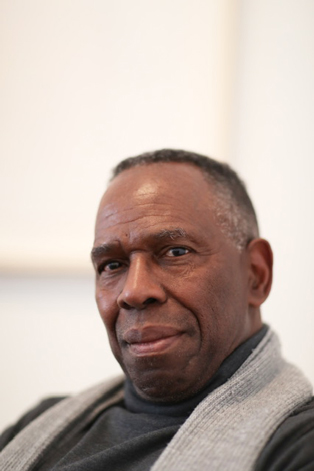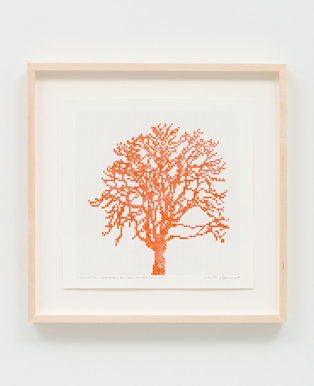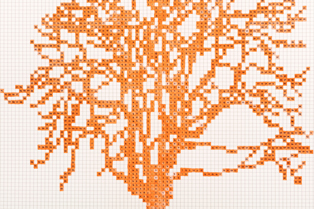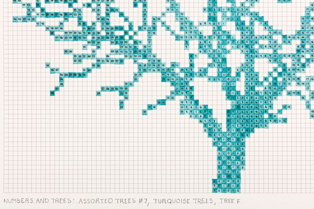




«Art as a Discipline: Charles Gaines»
Von Julieta Schildknecht
This interview features Charles Gaines (* 1944, Charleston) on the occasion of his first 2020 European exhibition at Hauser & Wirth in St. Moritz, which is dedicated to his drawing practice. Julieta Schildknecht met Gaines at the gallery. Below he shares his theoretical perspectives in an informal way.
Julieta Schildknecht: How would you describe your artwork in relation to the racial situation in the United States at the moment?
Charles Gaines: I’ve been making art a long time. Back in the 1970s, when I was a young practitioner, artists of color and women weren’t getting much recognition, nor exhibition opportunities. In those days, the Black Power movement and the civil rights movement brought forward certain political ideas about racism in America and activist strategies of doing something about it. As a Black artist, I had an awareness and experience of the politics of racism, and was trying to function as an artist making work within a larger situation that was not very open to artists of color.
Specifically, the white art world was marginalizing artists of color who were trying to carve out an independent space and aesthetic. My particular relation to that situation led me to begin working with numbers and systems. Yet the prevailing idea at that time was that art by minority artists should somehow reflect the political situation in which they found themselves. So, since my work was dealing with abstract ideas, some people of color considered this a problem, calling it “white art.” They asked: “Why doesn’t your art deal with us? Why are you making white art?” This was interesting to me—on one hand, it was an unfair question, but on the other, it was a legitimate issue because the work wasn’t grappling with the actuality of the political situation. I couldn’t really answer the question. I didn’t dismiss it, though.
Years later, I began to realize that my relationship to the type of work I was doing was a very personal one, and that in fact my interest in abstract constructs and ideas was a direct reflection of my experience as a Black person living in the United States. My interest in art didn’t come specifically from growing up in the South. Of course I had questions, like everyone: Why does such-and-such a law exist? Who makes these decisions? Why is race or colored skin a type of marked difference? Why do we have structures where some people are privileged and other people are marginalized?
I regard these as philosophical questions. They are political, but they are philosophical at the same time. Much later, I began to comprehend that my interest in language and representation came out of curious questions about representations with respect to race and skin color—how those definitions and differences are situated philosophically, beyond simplistic political framings.
JS: What do the trees mean to you?
CG: Trees themselves are not intrinsically significant to me. They are part of a mechanism, a system, in which to make artwork. Specifically they came about because of received ideas related to high modernism—that art is a discipline, a practice based upon the expression of one’s subjectivity. The idea that the total process of art is about the imagination, and that the experience of art is a response to some kind of communication between the subjectivity of the artist and the subjectivity of the viewer.
I did not agree with that, because for me, making art is a kind of performance. It’s a mise-en-scène that occurs at the studio. Somehow the tools that you use manifest intuitive realizations from your subjectivity, your imagination. I try to perform that ritual. I intuit an idea and find a way of making an object that is consequently related to the idea. Yet I perceive the gap between whatever I intuit and the object itself as so vast that it can be difficult to believe they have any relationship. So, what if there isn’t any connection between the cause (the intuition) and the effect (the artwork)? To me this is the basis of the idea of subjectivity and its operation.
JS: So you became very logical and explored forms and shapes through numbers?
CG: My interest was in using art to critique art and certain ideas of artistic practice, certain artistic values. I felt that expressivity wasn’t adequate in terms of my own interests. How could I make art? I was grappling with the very definition of art itself. After some research, I discovered that there are many ways to make art, and that the way I was understanding its making came out of a particular Eurocentric model, itself a product of a Eurocentric history. There are other cultures out there where everybody creates art objects and there is no theory of the imagination, no theory of expression. I saw this art being done in other locations and reframed my own problem: How could I apply this new knowledge to my own experience and to my own location? Could I find a strategy of making that didn’t involve my subjectivity?
This became the key: In the West, people take for granted a binary between rational thought and intuitive thought. Subjectivity operates in the realm of intuition, and doesn’t exist in the realm of logic. Which is wrong! The whole idea isn’t true.
JS: So we in the West are using a binary system constantly—without being aware of it. Was there ever a time when that wasn’t the case?
CG: There was a time in the 1960s and 1970s when certain strategies of art making really pushed at the binary. Conceptual art, the avant-garde. Definitions of art were being dramatically reconsidered.
JS: Would you say that your art is more accessible for its use of systems?
CG: Yes. Generally, if you make a painting or drawing, the marks are thought to be a function of your subjectivity. The materializations of intuition. Expressions. My work is critiquing this idea. What gives my marks resonance is that they are expressions that don’t emerge from the ontological mind. I am producing a work that comes from a logical mind. By doing that, I question the binary between objectivity and subjectivity—the idea of a clean split. No one operates either entirely intuitively or entirely logically. These two ways of thinking are always interlocked. So, my work is also a critique of the prevailing idea that I make paintings not out of intuition, but out of logic.
Your relationship to the work as a viewer is still based upon your poetic interpretation. But the marks are not subjective expressions; they are material manifestations of a system. My use of encrypted numbers is just a tool to do that.
JS: But—why trees?
CG: My trees emerged from the idea to make work systematically, by creating comparable relationships between similar or same-type objects, and have the differences that you perceive in those relationships be like expressions. If you imagine a tree, there is likely a particular tree that you are thinking of, because it’s just a concept. But when you look at a particular tree, you perceive that it is a variation on that general concept, and that there are many other possible instances. There are three trillion trees in the world, all reflecting on this singular idea of a tree. And then you have the conjunction of all those forms in one as the colorful Paradise Tree. I convert the tree-images into something that you can work with, a system, and in the process of system-building, I query the differences via the markings. The numbers do that, the colors do that. In other words, the purpose of all of those things is to mark the differences.
JS: Do you take photographs, or otherwise undertake research to find images that represent the differences you illustrate via your art manifestation?
CG: I perceive the tree—particularly the seedless trees—as an opportunity to make a system where I compare the differences between trees, or between trees and anything that would show up in the work of art as a manifestation of a type of difference. It could be a number, a space, a color—the system charts and plots the differences. I saw that I could convert the tree-image into a geometry, then apply the image to a system to reveal those differences.
JS: Do you perceive your work as related to our real-world environmental issues?
CG: No, the politics of my work relate to and criticize the way we understand things in general and in particular. That’s where the work’s politics lie. Global warming interests me and I am actively engaged with it, but I don’t use my work to advance that because the work advances a larger relationship to the world that already encompasses these things. Global warming is ideologically related to our economic systems—they lead to an ideology that justifies and legitimizes the capitalization of natural resources. What I am critiquing is the idea or structure that permits people to take such a view. It is a larger investigation. It’s political, but not embedded in any particular political issue.
JS: As you describe yourself in relation to your world, and your work in relation to yourself, I think about your musical compositions. Just like music is a language, you are making use of your particular language. Do you think music transcends racism, borders, time?
CG: Not at all. I don’t think music transcends cultural identification. My work is a critique of all sorts of ideas of universal transcendence. The work is about revealing, then critiquing, the ideology of transcendence. My interest in music is like my interest in the grid. In the Manifestos series, I translate political texts into music by decoding the letters of the text into musical notes. There is a kind of an affect when you listen to the music. Rather than suggesting that this affect is a product of my subjectivity, I assert that it is part of the system by which you experience it, and this relies on your cultural experience. So, it undermines the idea of transcendence.
Western culture loves to promote totalizing theories, absolute theories, which perpetuate absolutist notions—the idea that you can transcend culture, get beyond culture. I am totally critical of everything about that, all those ideas of absolutism and transcendence. I want my work to give you certain kinds of experiences that we conventionally attribute to ideas of transcendence, and reveal that they don’t come from transcendence—they are coming from culture, what you learned as an individual in a particular context of your gender, your race, your geography, and so forth. Nothing is actually transcendent.
JS: Everything is embedded in our personal experiences, in our particular environment.
CG: Yes, in the ways that you understand yourself. Your experience of a work of art is the product of your own life experiences. It doesn’t derive from an absolute construct that transcends culture. My work intends to demonstrate that by showing that one can have a poetic experience without relying on an assumption that frames poetry as a transcendent thing that supersedes culture.
JS: What are you teaching now?
CG: I teach mostly critical theory seminars at California Institute of the Arts. One is called “Content 1,” and it comes out of my conviction that art is a critical process. I try to introduce how criticality can work in the process of making art.
«Thinking in Thin Air – Anthology of a Decade Engadin Art Talks»
I.I. Engadin Art Talks, E.A.T. – the forum in Zuoz in the crystalline winter-wonderland of the Swiss Alps, takes place at the end of January each year and has become famous as a meeting point for thought leaders and disruptive minds.
The event is curated by Daniel Baumann, director of the Kunsthalle in Zurich, Bice Curiger, artistic director of the Vincent van Gogh Museum in Arles, Hans Ulrich Obrist, artistic director of the Serpentine Galleries in London, and Philip Ursprung, a history of art and architecture professor at the Swiss Federal Institute of Technology (ETH) in Zurich.
Thinking in Thin Air (Lars Müller publishers) makes it possible to experience the ideas of the artists, architects, and scientists who gather every winter to exchange thoughts of social-political relevance and visions of the future of art. On the occasion of the tenth anniversary of Engadin Art Talks, this book provides an insight into the special atmosphere of this event.
Designed like a pinboard, it can be read from any direction. It presents works by the participants, and offers a fascinating insight into the thinking and practice of some of the most important artists of our time in the form of essays, sketches, and works of art.
Trendsetter der Architektur, Malerei, Design
Dies ist ein Buch zum Schmökern. Man nimmt es in die Hand, blättert um und das Auge bleibt hängen, beispielsweise an den wunderbaren Aquarellzeichnungen der Engadiner Bergwelt von Oscar Tuazon.
«Thinking in Thin Air» versammelt die Trendsetter der Malerei, Architektur und Design. Jährlich im Januar finden in Zuoz im Engadin die «Engadin Art Talks» mit einem illustren Angebot statt.
Die Ausschnitte aus 10 Jahren E.A.T., Veranstaltungen und Vorträgen namhafter Autorinnen und Autoren, sind nun nachzulesen in der vorliegenden Publikation. Schade, dass alle Texte nur auf englisch sind, eine kurze Zusammenfassung der Texte in deutsch wären durchaus sinnvoll.
Es ist ein Buch zum Entdecken und man lernt einige neue Namen kennen und vertieft sich in die Texte, die so inspirierend wie bereichernd sind.
Cristina Bechtler, Finn Canonica (eds.)
Thinking in Thin Air
Anthology of a Decade Engadin Art Talks
Lars Müller publishers, 2020
With contributions by Julian Charrière, Hans Danuser,
Zvi Hecker, Ravit Helled, Thomas Hirschhorn, Bethan Huws,
Joanna Lesnierowska, Gianni Pettena, Tobias Rehberger,
Hans Jörg Ruch, Rolf Sachs, Michael Schindhelm, Juergen Teller,
Tomás Saraceno, Oscar Tuazon, Adrián Villar Rojas
Design: Atelier Landolt / Pfister
15 × 21 cm, 5 ¾ × 8 ¼ in
312 pages, 87 illustrations
Paperback
€ 28
ISBN 2020, 978-3-03778-624-6, English

